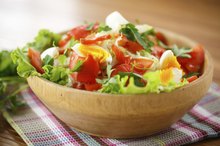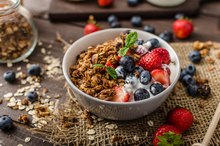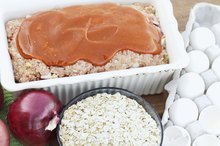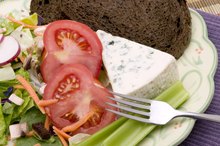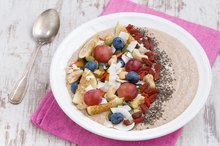Substitution for Wheat Germ
Although wheat is a whole grain, it’s often divided into the three components of bran, germ and endosperm during its processing. By itself, wheat germ is a wholesome and finely textured addition to hot or cold cereal, baked goods and protein shakes or smoothies. It has a number of potential substitutes, some of which are more common than others.
High-Fiber Substitutes
Wheat bran and ground flaxseed are two nutritionally dense substitutes for wheat germ that can work in baked goods or as garnishes on top of food. Wheat bran has just 30 calories per 1/4 cup but also boasts 2 grams of protein and 6 grams of fiber. Ground flaxseed is even more fiber-rich, with 7.5 grams per 1/4 cup. However, it’s also a heavier option, as 1/4 cup has 150 calories and 12 grams fat. In contrast, crude wheat germ has 105 calories, 6.5 grams of protein, 3 grams of fat, 15 grams of carbohydrates and 4 grams of fiber per 1/4 cup.
- Wheat bran and ground flaxseed are two nutritionally dense substitutes for wheat germ that can work in baked goods or as garnishes on top of food.
- Wheat bran has just 30 calories per 1/4 cup but also boasts 2 grams of protein and 6 grams of fiber.
Wheat-Free Options
Kamut & Gluten
Learn More
For people who avoid wheat germ because of issues with gluten intolerance or celiac disease, wheat bran is an inadequate substitute because it can exacerbate the same negative health issues. In baked goods, gluten-free substitutes for wheat germ include oat bran, rice bran, ground flaxseed and ground nuts. For a topping or garnish, try coarsely ground nuts or puffed brown rice.
Other Choices
Although substituting flour for wheat germ doesn’t work in toppings and garnishes, it is successful in baked goods. According to the University of Colorado Extension, 1 cup of all-purpose flour can stand in for 1/3 cup of wheat germ and 2/3 cup of all-purpose flour in any recipe. Adding more flour is a better choice than simply taking wheat germ out of a recipe, as balancing the wet and dry ingredients by staying true to their original amounts yields a superior result.
Considerations
Dijon Mustard Nutrition
Learn More
When you’re using wheat germ in baked goods, you’re working with specific chemical formulas that may not be as successful if you substitute ingredients. Although wheat germ does not normally alter the texture or flavor of baked goods in a dramatic way, removing it from a recipe or replacing it with a different substance may negatively impact texture or flavor, so it’s wise to start out by making small adjustments to any recipe.
Related Articles
References
- SkipThePie.org: Nutrition Search Engine - Wheat Germ
- Schagen SK, Zampeli VA, Makrantonaki E, Zouboulis CC. Discovering the link between nutrition and skin aging. Dermatoendocrinol. 2012;4(3):298-307. doi:10.4161/derm.22876
- National Institutes of Health. Vitamin E: Fact Sheet for Health Professionals. Updated February 28, 2020.
- Keen MA, Hassan I. Vitamin E in dermatology. Indian Dermatol Online J. 2016;7(4):311-5. doi:10.4103/2229-5178.185494
- Food Allergy Research & Education. Wheat Allergy.
- Berkeley Wellness. University of California. Should Anyone Take Vitamin E?. Published January 24, 2014.
Writer Bio
Carly Schuna is a Wisconsin-based professional writer, editor and copy editor/proofreader. She has worked with hundreds of pieces of fiction, nonfiction, children's literature, feature stories and corporate content. Her expertise on food, cooking, nutrition and fitness information comes from a Level 1 personal training certification and years of in-depth study.


